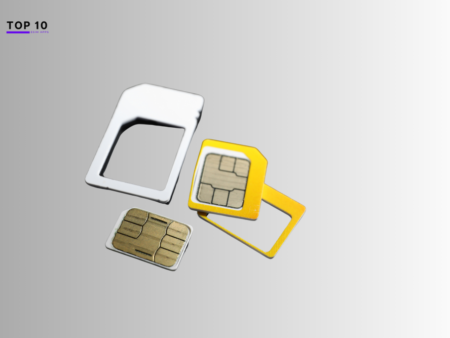The evolution of mobile technology is relentless, prompting a crucial question: which is superior, eSIM or physical SIM?
As telecommunications paradigms shift, the debate intensifies around embedded SIM (eSIM) versus traditional physical SIM cards – a choice with significant implications for connectivity and convenience.
Understanding SIM Technology
SIM, an acronym for Subscriber Identity Module, serves as the foundational cornerstone of mobile connectivity, playing an instrumental role in user identification and network access. Traditional physical SIM cards house user credentials in a physical form factor, typically a small plastic card inserted into a device. In contrast, eSIM technology embodies a digital SIM that is embedded directly into the device’s hardware, revolutionizing design flexibility and functionality. These contrasting approaches to subscriber authentication and carrier provisioning reflect wider industry shifts towards integrated solutions and enhanced user experiences.
Evolution from Physical to eSIM
The advent of eSIMs represents a paradigm shift in mobile connectivity. Their embedded nature eliminates the need for physical swapping, facilitating a seamless user experience.
As manufacturers increasingly integrate eSIM technology, the traditional physical SIM card’s prevalence wanes, signaling a move toward more robust and agile telecommunication infrastructures.
Embedded eSIM technology offers improved design freedom and increased device resilience against physical damage.
Transitioning to eSIMs not only simplifies device setup and carrier switching but also paves the way for slimmer, more innovative device form factors. Moreover, eSIMs enable greater security measures by reducing the attack vectors associated with physical SIM swapping frauds.
How eSIM Works Differently
eSIM technology operates by being soldered directly onto a mobile device’s motherboard, eschewing the need for a removable card. This embedded setup allows for on-the-fly network provisioning without physical exchange.
Carriers can activate services electronically via the internet, allowing instantaneous connectivity. No physical insertion or removal required.
The eSIM’s distinctive configuration permits multiple profiles to be stored on a single chip. This means you can switch between different carriers or plans without the need for separate SIM cards, offers greater flexibility, and facilitates international travel.
Moreover, the eSIM architecture lends itself to a more secure authentication protocol, leveraging advanced encryption methods to thwart potential security breaches. Coupling this with OTA (Over The Air) updates, the eSIM’s ability to receive new settings and software remotely positions it as a superior solution for connectivity management. Unlike traditional SIMs, these updates can “refresh” the eSIM’s credentials, making it more resilient to cloning or other forms of attack.
eSIM Advantages Explored
The eSIM technology heralds a new paradigm in manageability and convenience for mobile device users. With capabilities for dynamic profile management, the eSIM eliminates the cumbersome process of physically swapping cards when changing service providers or updating subscription details. This streamlined approach not only enhances user experience but also promotes a more agile and responsive interaction with telecom services.
Furthermore, the eSIM’s compact form factor is instrumental in fostering innovation in device design. By dispensing with the need for a physical SIM slot, manufacturers can reclaim valuable space for other components or functionalities, enabling sleeker, more feature-rich devices. This can be particularly advantageous in wearables and IoT devices, where real estate is at a premium.
Simplicity in Switching Carriers
Switching carriers with an eSIM is a remarkably seamless process that eliminates the physical limitations associated with SIM cards. In contrast to the traditional method, eSIMs offer a user-friendly, digitalized approach to changing network providers.
The procedure is as simple as selecting the desired carrier from your device’s settings, which then allows for the downloading and activation of the carrier’s profile almost instantaneously. This eliminates the logistical challenges of obtaining and handling physical SIM cards and significantly shortens the transition period. Moreover, it eradicates potential compatibility issues that may arise from mismatched SIM card types or sizes.
For travelers, the benefits are even more pronounced. Instead of purchasing local SIM cards in each destination, they can switch carriers digitally, often obtaining more competitive rates for data and calls. This digital process not only simplifies connectivity across borders but also ensures that users maintain a single, consistent device identity.
In corporate environments, managing mobile resources across a fleet of devices becomes vastly more efficient with eSIM technology. It allows IT departments to remotely assign and manage carrier profiles in response to changing organizational needs or employee roles. This level of administrative flexibility further extends to real-time response to changes in carrier service offerings, such as data plans and coverage, enabling a dynamic and cost-effective telecom strategy.
Benefits for International Travelers
International travelers reap immense benefits from the advent of eSIM technology, transforming their connectivity experience significantly.
- Seamless Network Switching: eSIM allows for smooth transitions between networks without the physical exchange of SIM cards, providing uninterrupted service as one crosses borders.
- Cost-Effective Data Plans: Access to local data plans at local rates without the need for multiple physical SIM cards translates to substantial savings on roaming fees.
- Simplified Device Management: With eSIMs, there’s no need to juggle multiple physical SIM cards, simplifying the management of your device’s connections.
- Enhanced Security: The risk of SIM card loss or theft is mitigated, as eSIM profiles are securely stored and easily recoverable.
With eSIM technology, the era of searching for compatible SIM cards and potential service interruptions is rapidly becoming a relic of the past.
The consolidation into a single, unified eSIM profile enhances security and convenience for travelers, ensuring peace of mind and a focus on the journey, not the tool of communication.
Space Saving in Device Design
Embedded SIM (eSIM) technology represents a paradigm shift, enabling sleeker device designs, absent the traditional SIM card tray. This eliminates a physical component, further refining the smartphone’s aesthetic.
A SIM slot removal offers tangible design freedoms. Devices can now be more compact or allocate space to augmented features.
Moreover, without the need for a SIM slot, designers can reallocate space for additional battery capacity or add new capabilities (like improved cooling mechanisms) without compromising the form factor.
This space reallocation is integral to manufacturing thinner devices without sacrificing performance features, fostering innovation that pushes the boundaries of modern smartphones.
Manufacturers aiming to waterproof their devices benefit from the omission of a SIM tray, significantly reducing the ingress points for water and dust. Such resilience enhances the device’s durability against environmental factors.
Conclusively, the move to eSIM is not only progressive in terms of connectivity and security but also a significant leap in device design and functionality, pushing manufacturers towards the zenith of efficiency and elegance.
The Case for Physical SIM Cards
The tangible nature of physical SIM cards offers a familiar form of control and ownership, embraced by continuous generations of mobile users.
With physical SIMs, the ability to swiftly switch devices or networks is effortless. Traveling individuals often rely on local SIM cards for cost efficiency, simple swaps facilitating immediate connectivity.
Additionally, the “tried-and-true” status of traditional SIM cards reinforces their reliability in a wide array of environments, resisting obsolescence.
Accessibility and Availability
The deployment of eSIM technology is far from ubiquitous, making physical SIMs more accessible globally.
- Geographic Disparities: eSIM’s availability is often limited to select regions and carriers.
- Device Constraints: Only recent and more advanced mobile devices support eSIM.
- Market Maturation: Physical SIMs dominate the market, ensuring widespread availability.
- User Familiarity: Consumers are more accustomed to the procurement and use of physical SIMs.
- Carrier Adaptation: Not all carriers are equipped to support eSIM profiles, complicating activation.
Whereas eSIMs necessitate a provisioning process that might be daunting for some users.
Physical SIM cards enjoy a more extensive and established distribution network, ensuring ease of procurement.
Physical Control over SIM Security
Traditional SIM cards confer a level of physical autonomy to users, ensuring a tangible sense of ownership and security. Users possess direct control over this small yet crucial component of their mobile device, a fact that instills a sense of assurance.
Direct handling facilitates immediate replacement or transfer. Should security concerns arise, physical SIMs can be swiftly removed and replaced, offering a clear and potent line of defense against potential misuse.
The physical nature of SIM cards allows users to maintain a visible token of their network identity, helpful during international travel where local SIMs may be temporarily required. This tangible aspect furnishes a form of security and control that is conspicuously absent with embedded solutions.
In contrast, the esoteric nature of eSIM technology can obscure the relationship between user, device, and carrier, complicating the direct application of user authority over the mobile identity. Despite advancements in encryption and security protocols, the absence of a physical token limits user engagement in safeguarding their mobile identity. Consequently, users may need to place greater trust in their service providers to manage and protect this aspect of their connectivity.
Compatibility and Consumer Choice
In the sphere of mobile telecommunications, the dichotomy between eSIMs and physical SIMs hinges on their compatibility with consumer devices and the latitude it affords users. While eSIMs are often hailed for their flexibility and their ability to streamline device design and function, their adoption is not yet universal, limiting their operability to a subset of modern smartphones and carriers. On the other hand, physical SIMs boast near-universal compatibility, providing consumers with the autonomy to select from a wide array of devices and networks. This expansive compatibility ensures that for the time being, physical SIM cards remain the default choice for consumers seeking unfettered access to diverse telecommunication ecosystems.
Device Support and Market Trends
The landscape of device support for SIM technology is in a state of flux, with eSIM capability becoming increasingly prevalent.
- Latest Smartphones and Connected Devices: Modern flagship smartphones are now routinely equipped with eSIM technology alongside or in place of traditional SIM slots.
- Telecommunication Operators: Major carriers are progressively adopting eSIM support, but the pace varies by region.
- Market Penetration and Consumer Adoption: eSIM-enabled device penetration is growing, with projected acceleration as more consumers recognize the benefits.
- Regulatory Environment: Policy-making bodies are beginning to address eSIM technology, which may affect the speed and manner of its adoption.
Despite this ongoing shift, the majority of mobile devices globally still rely on physical SIM cards.
The growing trend towards eSIM integration signifies a transformative phase that will likely redefine mobile device utilization and consumer expectations.
Assessing Your Mobile Needs
When considering mobile connectivity, the decision between eSIM and physical SIM is crucial. It hinges on the specific requirements and habits of the device user. Each option presents distinct advantages in flexibility, security, and global usability, which must align with the user’s mobile activity.
Since its inception, eSIM technology has posed a compelling proposition for frequent travelers, due to its ability to simplify the process of switching carriers. Without the need for a physical swap, one can seamlessly transition between networks to avoid roaming fees, a feature particularly advantageous for global nomads and business travelers.
However, it’s critical to review whether one’s mobile carrier supports eSIM and to what extent. While some carriers offer full functionality with eSIM, others may still be in the transition phase, limiting features or availability. Researching the level of eSIM support provided by your preferred carriers is essential.
Physical SIM cards, on the other hand, offer tangible control over one’s connectivity. For those who prefer the tactile reassurance of a physical card or live in areas with limited eSIM support, traditional SIMs may be the more practical choice. This is particularly relevant in regions where carrier competition and eSIM infrastructure may not be as developed.
Ultimately, the choice between eSIM and physical SIM must be based on a thorough investigation of personal needs and practicalities. One’s decision should balance immediate convenience against broader considerations such as network compatibility, accessibility, and personal preferences for managing connectivity.











